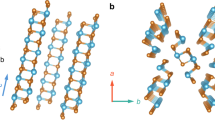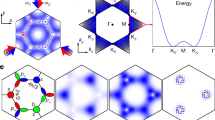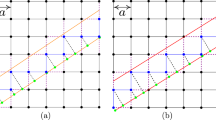Abstract
Although it is widely accepted that to resolve the ‘horizon’ problem the early Universe must have undergone a sudden expansion (cosmic inflation), what mechanism drove this process is less clear. In the braneworld scenario, it is suggested that inflationary epochs may have been initiated and terminated by brane collisions and annihilations1,2,3. Branes are objects of lower dimensionality embedded in a higher-dimensional matrix. For example, we may live on a three-dimensional brane embedded in a four-dimensional matrix. However, such structures are so far removed from everyday reality that bringing physical insight to bear is difficult. Here we report laboratory experiments where we simulate brane annihilation using the closest brane analogue to which we have access, the coherent phase boundary between the two phases of superfluid 3He. When two branes collide or annihilate, topological defects may be created, whose influence may still be detectable today. By creating a brane–antibrane pair in superfluid 3He and subsequently annihilating it, we can detect that defects are indeed created in the superfluid texture (the superfluid analogue of spacetime), thus confirming that the concept of defect formation after brane annihilation in the early Universe can be reproduced in analogous systems in the laboratory.
This is a preview of subscription content, access via your institution
Access options
Subscribe to this journal
Receive 12 print issues and online access
$259.00 per year
only $21.58 per issue
Buy this article
- Purchase on SpringerLink
- Instant access to full article PDF
Prices may be subject to local taxes which are calculated during checkout




Similar content being viewed by others
References
Dvali, G. & Tye, S. H. Brane inflation. Phys. Lett. B 450, 72–82 (1999).
Burgess, C. P. et al. The inflationary brane anti-brane universe. J. High Energy Phys. 07, 047 (2001).
Dvali, G., Shafi, Q. & Solganik, S. D-brane inflation. Preprint at <http://arxiv.org/abs/hep-th/0105203> (2001).
Volovik, G. E. The Universe in a Helium Droplet (Oxford Univ. Press, Oxford, 2003).
Bartkowiak, M. et al. Interfacial energy of the superfluid 3He A–B phase interface in the zero-temperature limit. Phys. Rev. Lett. 93, 045301 (2004).
Sarangi, S. & Tye, S.-H. H. Cosmic string production towards the end of brane inflation. Phys. Lett. B 536, 185–192 (2002).
Fisher, S. N., Guénault, A. M., Kennedy, C. J. & Pickett, G. R. Blackbody source and detector of ballistic quasiparticles in 3He-B: Emission angle from a wire moving at supercritical velocity. Phys. Rev. Lett. 69, 1073–1076 (1992).
Brinkman, W. F., Smith, H., Osheroff, D. D. & Blount, E. I. Anisotropy in the B phase of He3. Phys. Rev. Lett. 33, 624–627 (1974).
Majumdar, M. & Davis, A.-C. Cosmological creation of D-branes and anti-D-branes. J. High Energy Phys. 03, 056 (2002).
Maki, K. & Kumar, P. solitons (planarlike n textures) in superfluid 3He-B. Phys. Rev. B 16, 4805–4814 (1977).
Acknowledgements
We thank the UK EPSRC, the Royal Society and the ESF Network COSLAB for financial support, I. E. Miller and M. G. Ward for technical support and A. Achúcarro, A. C. Davis, H. E. Hall, T. Kibble, A. Vilenkin and G. E. Volovik for discussions.
Author information
Authors and Affiliations
Contributions
All authors contributed equally to this work.
Corresponding author
Rights and permissions
About this article
Cite this article
Bradley, D., Fisher, S., Guénault, A. et al. Relic topological defects from brane annihilation simulated in superfluid 3He. Nature Phys 4, 46–49 (2008). https://doi.org/10.1038/nphys815
Received:
Accepted:
Published:
Issue date:
DOI: https://doi.org/10.1038/nphys815
This article is cited by
-
Topological superfluid defects with discrete point group symmetries
Nature Communications (2022)
-
Quantum nucleation of topological solitons
Journal of High Energy Physics (2022)
-
Controlled creation and decay of singly-quantized vortices in a polar magnetic phase
Communications Physics (2021)
-
Controlled creation of a singular spinor vortex by circumventing the Dirac belt trick
Nature Communications (2019)
-
The A-B transition in superfluid helium-3 under confinement in a thin slab geometry
Nature Communications (2017)



